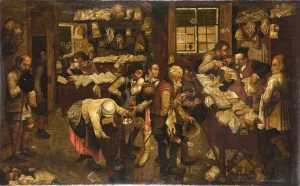At the end of this month, a rare work by the seventeenth-century Flemish painter Pieter Bruegel the Younger will be going to auction in Paris. What has many people talking about it, though, is where it came from. For more than a century, it’s been hanging, relatively forgotten, behind a door in a family home in northern France.
Probably one of the most noticeable things about this work, for anyone familiar with Brueghel the Younger’s oeuvre, is the large canvas. It measures nearly three-and-a-half feet by six feet, almost twice the size of most Brueghel works. The painting is one of Brueghel’s variations of his work L’Avocat du village, or The Village Lawyer, created around 1617. Also called The Payment of the Tithe, the work shows a well-dressed, greedy lawyer inspecting his papers as he collects taxes from the village farmers, who bring money and agricultural goods like eggs or fowl. Many art historians theorize that the work is a social commentary on Spanish rule of the Netherlands, which continued until 1714, mainly by showing the tax-collecting lawyer with a prominent jaw, which was common in the portraits of the ruling Habsburg family. This is a subject that Brueghel painted dozens of times, with versions owned by the Museum of Fine Arts in Ghent and the Grohmann Museum in Milwaukee, all of which are far smaller than the recently-discovered version. One version sold last December at a Sotheby’s London Old Masters sale for a hammer of £210K (or $256K).
The family who owns the work, who have chosen to remain anonymous, knew it was a Brueghel but thought it was only a copy. The painting has hung in the house since about 1900, with no documentation before then attesting to the work’s provenance. The family had several items in the home valued by the French auction house Daguerre Val de Loire when specialists came across the painting. Specialists from the Louvre and Cabinet Turquin took a look at it before sending the work to Germany to Brueghel expert Klaus Ertz. Once a positive attribution was made to Pieter Brueghel the Younger, the family decided to consign the work to the Paris auction house Drouot, who are featuring it in their upcoming March 28th sale alongside works by Hyacinthe Rigaud and Jean-Marc Nattier. The painting will likely be the sale’s top lot, with specialists giving it an estimated range of between €600K and €800K (or $642K and $856K).

